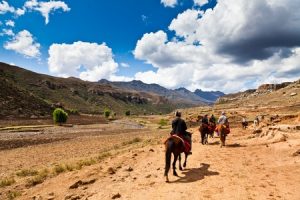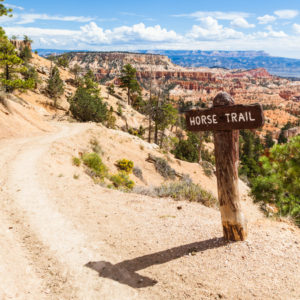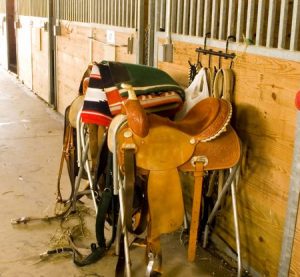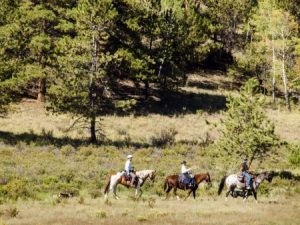It’s not surprising that trail riding is such a popular equestrian activity – it gives you the opportunity to relax, unwind and spend quality time with your friends, your family and of course, with your horse. When you’re out trail riding with your horse, you get to discover all sorts of new exciting places and enjoy the beautiful scenery of rolling hills and winding trails. Your horse, too, can benefit from being on a trail ride, especially since it’s something new and different for him and is a nice change from his regular riding routine. Whether you want to go for a short ride on a local trail or you’ve decided to head out for an all-day excursion, here are some tips to help you have a fun, safe, relaxing ride.
Planning Your Trail Ride
Before you pack up and go trail riding with your horse, you’ll need to do a little planning so that you can have an enjoyable and successful ride. First, think about your horse’s age, his physical condition and his level of experience on trails. Do you have a younger horse who is inexperienced or has never been on a trail ride before? Or do you have an older horse who might not be up for a long, physically challenging ride? Maybe your horse is a seasoned pro who has been on both short and long rides and is physically fit for most trail riding activities. Your horse’s age, maturity level and experience on trails are all important factors that you’ll need to consider when you’re planning your trail ride.
For safety reasons, it’s always better to ride with other people instead of riding by yourself. So as part of your preparation, think about who you would like to invite to join you on your trail ride. You’ll want to go with people who understand the importance of both riding safety and also know how to follow proper trail etiquette. It’s also important to go with riders who are compatible with your riding style and riding preferences. Find out in advance if the other riders like to go out on flat, wide trails or if they prefer to ride on more challenging, steeper terrain. Also, ask the other riders what pace they would like to maintain during the ride – do they want to stay at a leisurely walk or do they want to trot or lope? You’ll probably want to ride with others who enjoy the same style and speed of trail riding that you like. Additionally, you’ll also want to find out which riders are experienced at trail riding and which people are novice riders who perhaps have never been on a trail ride before. You’ll want to put the more experienced riders in the front and at the back of the line, while keeping the less experienced riders in the middle. This way, the experienced riders can look out for and help those with less experience, which will help make the ride safer and more enjoyable for everyone.
As part of your planning, you’ll also want to learn a little bit about the other horses that you are riding with. Are these horses seasoned, trusty steeds who have been exposed to all sorts of different trails and the associated experiences that come along with trail riding? Or is this the first time they’ve been outside of an arena and this is a brand-new adventure for them? Depending on your preference, you might want to ride with other horses that have experience on trails. Or you might enjoy going out with someone who has a horse that is new to trail riding, so you can help mentor and guide your friend and his horse. You’ll also want to find out before you go out on your ride which horse (or horses) in the group tend to be dominant, which horses kick or bite when they get close to other horses, and which horses tend to walk slow or fast. By gathering all of this information in advance, you can plan where each rider and horse should be placed in the ride.
Next, you’ll need to plan and map out where you want to go trail riding with your horse. If you’re not quite sure exactly where you want to ride, you can join a local trail riding club or do some online research on equestrian trails near you. Once you’ve picked a location for your trail ride, you should call the park grounds before you leave on your trip so you can get up to date information from the rangers who manage the area. You’ll want to ask about the conditions of the trails, find out which trails are permitted for equestrian use, and see if there are any hazardous conditions that you need to be aware of. You should also decide in advance how long you want to be out on your ride and then share these details with a family member or friend who’s not going with you. Once you’re out on the trails, be sure that you have some form of emergency communication, such as a cellphone, so you can call for help in case of an emergency. If you’re riding in an area where there are park rangers, you’ll want to check in with them when you first arrive and let them know where you are planning to ride as well as how long you plan to be gone.
Most people like to trail ride in the spring or fall when the weather typically is mild, but you should still check the weather conditions in your area before you head out for your ride regardless of the time of year. If it looks like there’s going to be rain and thunderstorms in the forecast, or if you find out there’s a big heatwave moving in, you should reschedule your ride for another day when the weather is more pleasant. Both you and your horse will have a lot more fun on your ride if you go out on a day when the weather is pleasant.
Getting Ready For Your Trail Ride
Now that you’ve decided where you want to go for your ride, there are a few things you’ll need to do to properly prepare for the trip. First, you’ll want to thoroughly check your tack to make sure it’s in good working condition. The last thing you want is for something to fail while you’re out on the trail! Check your horse’s bridle and saddle and look for any signs of tears or cracks. Also check the hardware and screws and make sure nothing is loose or broken. You’ll find that if you take care of your tack by regularly cleaning and conditioning the leather, you’re less likely to end up with tack that becomes dry or brittle. You’ll also want to inspect your saddle pad and make sure that it’s clean and free of dirt or debris that could potentially irritate your horse during the ride. Check his halter and lead line, making sure that the halter clasp works properly and that the lead line is not worn or frayed. And, of course, you will need to thoroughly perform a safety check on your horse trailer before you load your horse and leave for your ride.
The tack and gear that you’ll need to bring for your trail ride really depends on where you’re going and how long you plan to be gone. However, even for a simple day trip, there are still some basic items that you’ll need to pack for both you and your horse.
For your horse, you’ll want to bring his tack including his halter, lead line, bridle, saddle and saddle pad. It’s always a good idea to bring an extra bridle, saddle and saddle pad just in case something breaks or gets damaged while you’re away from home. Also, depending on the type of terrain that your horse is going to be exposed to during your trail ride, you might want to bring along a breast collar as well as protective gear such as polo wraps, bell boots and maybe a fly bonnet (especially if you are in an area where there will be flies or gnats). You should also pack an extra halter and lead rope that you can bring on the trail with you – that way, if you decide you want to stop and rest for a while, you’ll be able to safely tie your horse while you’re out on the trail. You’ll also need to bring your basic grooming supplies such as brushes, curry combs and a couple of hoof picks. And if you’re in an area where flies are a problem, you can also bring a bottle of fly spray.
For yourself, you’ll want to wear comfortable, loose fitting clothes for the ride. Try to pick colors that are easily visible, and you may even want to wear a reflective vest. You’ll need to bring (and wear!) your riding helmet and if you’re going to be gone for several hours you should also consider bringing a saddlebag. That way, you can easily pack and carry items such as a hoof pick, pocket knife, sunscreen, bug repellent, lip balm, water and lunch in the saddlebag. You’ll also want to bring your fully charged cellphone and keep it in a case that clips securely to your belt. A cellphone could save your life if you ever get lost or fall off your horse. So keep it close to you in person, not on your saddle or in a saddlebag, and have some friends and family members on speed dial in case you need to reach them.
When you’re ready to start packing your trailer for your trail ride, you’ll want to bring along some extra items for your horse, too. In addition to extra tack and grooming supplies, you should also bring a first aid kit, water buckets, a muck bucket and a mucking rake. You’ll also want to pack some extra hay and fresh drinking water for both you and your horse, too.
On the Trail
While you’re out on your trail ride, there are a few rules and trail etiquette that you’ll want to follow. You should try to stay on trails that are marked specifically for equestrian use – typically you’ll see signs that are posted on the sides of the trail. If you’re riding with a group of people, you’ll want to ride in single file so that you don’t disrupt or destroy the natural surroundings. Also, make sure you keep plenty of distance between you and the other horses, and keep the experienced riders in both the front and back of the line. If the people that you’re riding with are matched in their riding skills, then you can each take turns leading the trail ride. As you’re traveling along the trails, always pay attention to your surroundings so that you don’t put you or your horse in a dangerous situation. You’ll want to pay extra close attention to the ground and footing, and keep your horse in areas where he won’t slip or trip over debris or obstacles hidden by tall grass or fallen leaves. If you’re in a location where you need to cross water, make sure you know the depth of the water before you try crossing it.
During your ride there’s a good chance that you’ll encounter other trail riders, hikers or bikers, so you’ll want to be considerate of the other folks that are on the trail with you. Most likely you will also encounter people with dogs during your ride, since many people like to go hiking with their dogs. The dogs may or may not be on leashes, so be aware of your surroundings and watch for loose dogs that may dart up onto the trail and surprise you and your horse.
Both during and after your trail ride, you’ll want to be courteous and clean up after yourself. Be sure to pick up any food, trash or manure so that you leave the park and trails in the same pristine condition as when you arrived. Once you’ve gone back to your trailer, you’ll want to untack your horse and groom him thoroughly after the ride. Check his legs carefully to make sure he didn’t scratch himself while you were out on the trail and also look for any insect bites or ticks that might be on his legs or belly. If you have access to water and a hose, you can give your horse a bath and rinse him off, especially if it’s a warm day.
Trail riding with your horse can be a lot of fun, and it’s a great way to spend time with a group of friends or meet new people in a riding club. Do you like to go trail riding with your horse? If so, let us know where you like to ride and please share any other tips that you have.









Leave a Reply